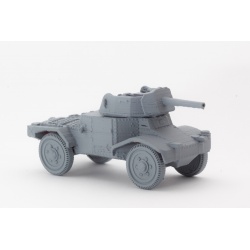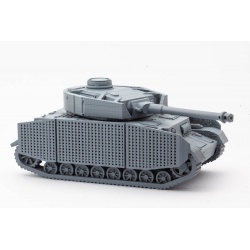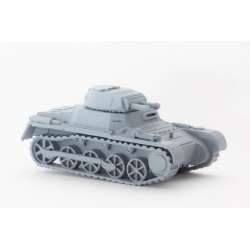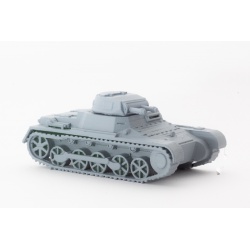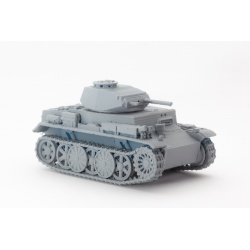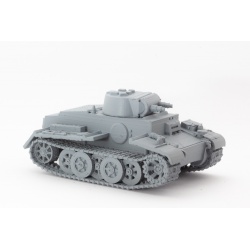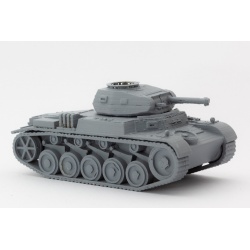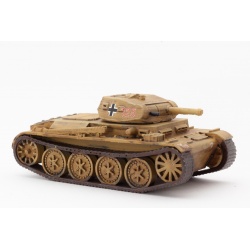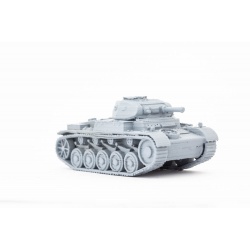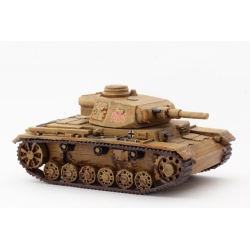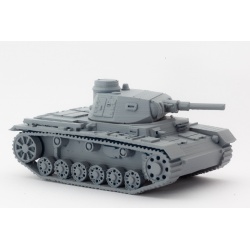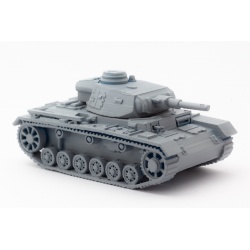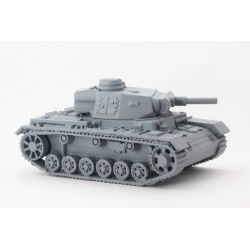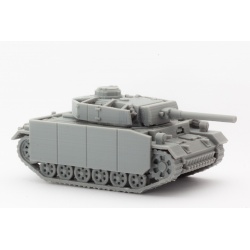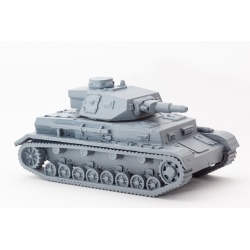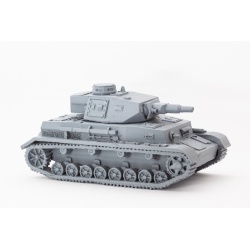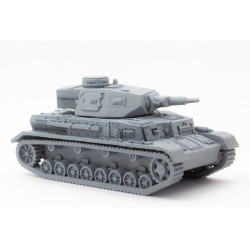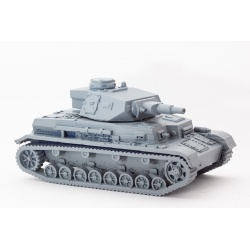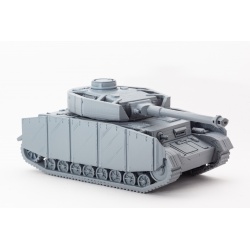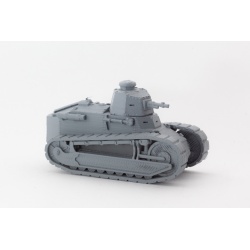TigerAce1945
![]()
Panzerspähwagen P204(f)
Model comes in two parts; body and turret.
When Germany invaded France they captured some 190 Panhard 178s and repurposed them as Panzerpahwagen P204(f). They saw action during Operation Barbarossa. The turret was removed and it was placed by an open 5 cm KwK 38 L/42 gun.
When Germany invaded France they captured some 190 Panhard 178s and repurposed them as Panzerpahwagen P204(f). They saw action during Operation Barbarossa. The turret was removed and it was placed by an open 5 cm KwK 38 L/42 gun.
Captured French Panhard 178
Pz. IV Ausf J
This model comes in 4 parts; Hull, Turret & tracks.
Officially designated as the Sd.Kfz 161, the Panzerkampfwagen IV was developed in the 1930s and was the most widely manufactured German tank of WWII.
Over 8,500 units in varying designations were built. Its chassis was used as the base for many other vehicles, notably the StuG, Jagdpanzer, Wirbelwind, Hummel, Nashorn and Brummbar.
The Panzer IV saw service on all German fronts. It also saw service in Syria in the 1967 Six Day War.
The tank came in various designations from A-J with varying armour and weapons. It was supplied to the armies of Romania, Hungary, Bulgaria, Spain, Finland and Italy.
This model comes with the mesh Schurzen (skirts) and is fitted with a 7.5 cm KwK 40 L/48 gun.
The Ausf J was produced between February 1944 and April 1945 and 3,120 were built.
Officially designated as the Sd.Kfz 161, the Panzerkampfwagen IV was developed in the 1930s and was the most widely manufactured German tank of WWII.
Over 8,500 units in varying designations were built. Its chassis was used as the base for many other vehicles, notably the StuG, Jagdpanzer, Wirbelwind, Hummel, Nashorn and Brummbar.
The Panzer IV saw service on all German fronts. It also saw service in Syria in the 1967 Six Day War.
The tank came in various designations from A-J with varying armour and weapons. It was supplied to the armies of Romania, Hungary, Bulgaria, Spain, Finland and Italy.
This model comes with the mesh Schurzen (skirts) and is fitted with a 7.5 cm KwK 40 L/48 gun.
The Ausf J was produced between February 1944 and April 1945 and 3,120 were built.
J model with Schurzen
Pz.Kpfw I Ausf A
Model comes in two parts; hull and turret.
The Panzer I was designed in 1932 and went into production in 1934. It saw action in the Spanish Civil War, in WWII in Poland, France, Russia and North Africa. It also saw action in China during the second Sino-Japanese War.
It weighed 5.4 tonnes and had a crew of two; commander and driver.
It was armed with two 7.92mm MG13 machine guns.
The Panzer I was designed in 1932 and went into production in 1934. It saw action in the Spanish Civil War, in WWII in Poland, France, Russia and North Africa. It also saw action in China during the second Sino-Japanese War.
It weighed 5.4 tonnes and had a crew of two; commander and driver.
It was armed with two 7.92mm MG13 machine guns.
Panzerkampfwagen I
Pz.Kpfw I Ausf B
Model comes in two parts; hull and turret.
The Panzer I was designed in 1932 and went into production in 1934. It saw action in the Spanish Civil War, in WWII in Poland, France, Russia and North Africa. It also saw action in China during the second Sino-Japanese War.
640 took part in the French Campaign but by the end of 1940 they were being phased out.
It weighed 5.8 tonnes and had a crew of two; commander and driver. The Ausf B was longer than the A and had an extra wheel.
It was armed with two 7.92mm MG13 machine guns.
The Panzer I was designed in 1932 and went into production in 1934. It saw action in the Spanish Civil War, in WWII in Poland, France, Russia and North Africa. It also saw action in China during the second Sino-Japanese War.
640 took part in the French Campaign but by the end of 1940 they were being phased out.
It weighed 5.8 tonnes and had a crew of two; commander and driver. The Ausf B was longer than the A and had an extra wheel.
It was armed with two 7.92mm MG13 machine guns.
Panzerkampfwagen I
Pz.Kpfw I Ausf C
Model comes in two parts; hull and turret.
The Panzer I was designed in 1932 and went into production in 1934. It saw action in the Spanish Civil War, in WWII in Poland, France, Russia and North Africa. It also saw action in China during the second Sino-Japanese War.
It weighed 5.4 tonnes and had a crew of two; commander and driver.
It was armed with two 7.92mm MG13 machine guns.
The I Ausf C was designed in 1939. It was armed with a Mauser EW 141 semi-automatic anti-tank rifle, with a 50-round drum, firing armor-piercing 7.92x94mm Patrone 318 anti-tank rounds.
40 Models were made plus 6 prototypes.
The Panzer I was designed in 1932 and went into production in 1934. It saw action in the Spanish Civil War, in WWII in Poland, France, Russia and North Africa. It also saw action in China during the second Sino-Japanese War.
It weighed 5.4 tonnes and had a crew of two; commander and driver.
It was armed with two 7.92mm MG13 machine guns.
The I Ausf C was designed in 1939. It was armed with a Mauser EW 141 semi-automatic anti-tank rifle, with a 50-round drum, firing armor-piercing 7.92x94mm Patrone 318 anti-tank rounds.
40 Models were made plus 6 prototypes.
Pz.Kpfw I Ausf F
Model comes in two parts; hull and turret.
The Panzer I was designed in 1932 and went into production in 1934. It saw action in the Spanish Civil War, in WWII in Poland, France, Russia and North Africa. It also saw action in China during the second Sino-Japanese War.
It weighed 5.4 tonnes and had a crew of two; commander and driver.
The Ausf F variant was armed with two 7.92mm MG-34 machine guns. It weighed 18-21 tonnes. Thirty were produced in 1940 but a later order for 100 more was cancelled.
The Panzer I was designed in 1932 and went into production in 1934. It saw action in the Spanish Civil War, in WWII in Poland, France, Russia and North Africa. It also saw action in China during the second Sino-Japanese War.
It weighed 5.4 tonnes and had a crew of two; commander and driver.
The Ausf F variant was armed with two 7.92mm MG-34 machine guns. It weighed 18-21 tonnes. Thirty were produced in 1940 but a later order for 100 more was cancelled.
Pz.Kpfw II Ausf C
Model comes in four parts; hull, tracks & turret.
There were only a few minor changes between the C and previous models. 75 were built between March 1937 and April 1940. It added a ton in weight up to 8.9 tons and had a more powerful engine.
They were armed with a 2cm Kwk 30 main gun and a 7.92mm MG34 machine gun.
There were only a few minor changes between the C and previous models. 75 were built between March 1937 and April 1940. It added a ton in weight up to 8.9 tons and had a more powerful engine.
They were armed with a 2cm Kwk 30 main gun and a 7.92mm MG34 machine gun.
Panzer II C
Pz.Kpfw II Ausf D
Model comes in four parts; hull, tracks & turret.
The ausf D version retained the same turret as the ausf C but used a new hull and superstructure. It was shorter but wider and taller than the C.
SA total of 43 Ds were built from October 1938 to March 1939. They were withdrawn from service in 1940 when the remaining units were converted to flamethrower tanks.
They were armed with a 2cm Kwk 30 main gun and a 7.92mm MG34 machine gun.
The ausf D version retained the same turret as the ausf C but used a new hull and superstructure. It was shorter but wider and taller than the C.
SA total of 43 Ds were built from October 1938 to March 1939. They were withdrawn from service in 1940 when the remaining units were converted to flamethrower tanks.
They were armed with a 2cm Kwk 30 main gun and a 7.92mm MG34 machine gun.
Panzer II D
Pz.Kpfw II Ausf F
Model comes in four parts; hull, tracks & turret.
The F was the last major design in the Pz II series. Between March 1941 and December 1942, 524 were built. It was amred with a 2cm KwK 30 main gun and a 7.92mm MG34.
The F was the last major design in the Pz II series. Between March 1941 and December 1942, 524 were built. It was amred with a 2cm KwK 30 main gun and a 7.92mm MG34.
Panzer II F
Pz.Kpfw III Ausf E
This model comes in 2 parts; Hull and turret. The turret is available with or without schurzen side armour plates.
The Panzer III saw service throughout the entire war being produced between 1939 and 1943. It came in at 23 tonnes and had a crew of five (commander, gunner, loader, driver & radio op/machine gunner).
5,774 were built.
The Ausf A to G were equipped with a 3.7cm KwK 36 L/45 gun which was later upgraded to the 5cm KwK 38 L/42 gun for later Ausf F to J versions. Models were equipped with two 7.92mm MG34 machine guns.
The Panzer III was first used in the Poland campaign and saw service throughout the war in Europe and north Africa.
96 Ausf E versions were made in 1939 and 45 Ausf E command tanks were made in 1939 & 1940. Armour was increased to 30mm and the suspension was changed to include 6 road wheels.
The Panzer III saw service throughout the entire war being produced between 1939 and 1943. It came in at 23 tonnes and had a crew of five (commander, gunner, loader, driver & radio op/machine gunner).
5,774 were built.
The Ausf A to G were equipped with a 3.7cm KwK 36 L/45 gun which was later upgraded to the 5cm KwK 38 L/42 gun for later Ausf F to J versions. Models were equipped with two 7.92mm MG34 machine guns.
The Panzer III was first used in the Poland campaign and saw service throughout the war in Europe and north Africa.
96 Ausf E versions were made in 1939 and 45 Ausf E command tanks were made in 1939 & 1940. Armour was increased to 30mm and the suspension was changed to include 6 road wheels.
Pz.Kpfw III Ausf F
This model comes in 2 parts; Hull and turret. The turret is available with or without schurzen side armour plates.
The Panzer III saw service throughout the entire war being produced between 1939 and 1943. It came in at 23 tonnes and had a crew of five (commander, gunner, loader, driver & radio op/machine gunner).
5,774 were built.
The Ausf A to G were equipped with a 3.7cm KwK 36 L/45 gun which was later upgraded to the 5cm KwK 38 L/42 gun for later Ausf F to J versions. Models were equipped with two 7.92mm MG34 machine guns.
The Panzer III was first used in the Poland campaign and saw service throughout the war in Europe and north Africa.
450 Ausf F versions were made between 1939 and 1941.
The Panzer III saw service throughout the entire war being produced between 1939 and 1943. It came in at 23 tonnes and had a crew of five (commander, gunner, loader, driver & radio op/machine gunner).
5,774 were built.
The Ausf A to G were equipped with a 3.7cm KwK 36 L/45 gun which was later upgraded to the 5cm KwK 38 L/42 gun for later Ausf F to J versions. Models were equipped with two 7.92mm MG34 machine guns.
The Panzer III was first used in the Poland campaign and saw service throughout the war in Europe and north Africa.
450 Ausf F versions were made between 1939 and 1941.
Pz.Kpfw III Ausf G
This model comes in 2 parts; Hull and turret. The turret is available with or without schurzen side armour plates.
The Panzer III saw service throughout the entire war being produced between 1939 and 1943. It came in at 23 tonnes and had a crew of five (commander, gunner, loader, driver & radio op/machine gunner).
5,774 were built.
The Ausf A to G were equipped with a 3.7cm KwK 36 L/45 gun which was later upgraded to the 5cm KwK 38 L/42 gun for later Ausf F to J versions. Models were equipped with two 7.92mm MG34 machine guns.
The Panzer III was first used in the Poland campaign and saw service throughout the war in Europe and north Africa.
594 Ausf G versions were made in 1940 and 1941. It had extra armour on the gun mantlet and later versions had the 5 cm KwK 38 L/42 main gun.
The Panzer III saw service throughout the entire war being produced between 1939 and 1943. It came in at 23 tonnes and had a crew of five (commander, gunner, loader, driver & radio op/machine gunner).
5,774 were built.
The Ausf A to G were equipped with a 3.7cm KwK 36 L/45 gun which was later upgraded to the 5cm KwK 38 L/42 gun for later Ausf F to J versions. Models were equipped with two 7.92mm MG34 machine guns.
The Panzer III was first used in the Poland campaign and saw service throughout the war in Europe and north Africa.
594 Ausf G versions were made in 1940 and 1941. It had extra armour on the gun mantlet and later versions had the 5 cm KwK 38 L/42 main gun.
Panzerkampfwagen III
Pz.Kpfw III Ausf H
This model comes in 2 parts; Hull and turret.
The Panzer III saw service throughout the entire war being produced between 1939 and 1943. It came in at 23 tonnes and had a crew of five (commander, gunner, loader, driver & radio op/machine gunner).
5,774 were built.
The Ausf A to G were equipped with a 3.7cm KwK 36 L/45 gun which was later upgraded to the 5cm KwK 38 L/42 gun for later Ausf F to J versions. Models were equipped with two 7.92mm MG34 machine guns.
The Panzer III was first used in the Poland campaign and saw service throughout the war in Europe and north Africa.
286 Ausf H versions were made between 1940 and 1941, plus 175 command tank versions
The Panzer III saw service throughout the entire war being produced between 1939 and 1943. It came in at 23 tonnes and had a crew of five (commander, gunner, loader, driver & radio op/machine gunner).
5,774 were built.
The Ausf A to G were equipped with a 3.7cm KwK 36 L/45 gun which was later upgraded to the 5cm KwK 38 L/42 gun for later Ausf F to J versions. Models were equipped with two 7.92mm MG34 machine guns.
The Panzer III was first used in the Poland campaign and saw service throughout the war in Europe and north Africa.
286 Ausf H versions were made between 1940 and 1941, plus 175 command tank versions
Panzer III
Pz.Kpfw III Ausf M (Schurzen)
This model comes in 2 parts; Hull and turret and is the version with schurzen side armour plates.
The Panzer III saw service throughout the entire war being produced between 1939 and 1943. It came in at 23 tonnes and had a crew of five (commander, gunner, loader, driver & radio op/machine gunner).
5,774 were built.
The Ausf A to G were equipped with a 3.7cm KwK 36 L/45 gun which was later upgraded to the 5cm KwK 38 L/42 gun for later Ausf F to J versions. Models were equipped with two 7.92mm MG34 machine guns.
The Panzer III was first used in the Poland campaign and saw service throughout the war in Europe and north Africa.
The M version was produced in 1942 and 1943 and 517 were built. There were minor modifications to the L version including a long 5cm gun and deep wading exhaust.
The Panzer III saw service throughout the entire war being produced between 1939 and 1943. It came in at 23 tonnes and had a crew of five (commander, gunner, loader, driver & radio op/machine gunner).
5,774 were built.
The Ausf A to G were equipped with a 3.7cm KwK 36 L/45 gun which was later upgraded to the 5cm KwK 38 L/42 gun for later Ausf F to J versions. Models were equipped with two 7.92mm MG34 machine guns.
The Panzer III was first used in the Poland campaign and saw service throughout the war in Europe and north Africa.
The M version was produced in 1942 and 1943 and 517 were built. There were minor modifications to the L version including a long 5cm gun and deep wading exhaust.
Pz.Kpfw IV Ausf B
This model comes as four parts; hull, turret and tracks.
Officially designated as the Sd.Kfz 161, the Panzerkampfwagen IV was developed in the 1930s and was the most widely manufactured German tank of WWII.
Over 8,500 units in varying designations were built. Its chassis was used as the base for many other vehicles, notably the StuG, Jagdpanzer, Wirbelwind, Hummel, Nashorn and Brummbar.
The Panzer IV saw service on all German fronts. It also saw service in Syria in the 1967 Six Day War.
The tank came in various designations from A-J with varying armour and weapons. It was supplied to the armies of Romania, Hungary, Bulgaria, Spain, Finland and Italy.
42 Bs were built between May and October 1938.
Officially designated as the Sd.Kfz 161, the Panzerkampfwagen IV was developed in the 1930s and was the most widely manufactured German tank of WWII.
Over 8,500 units in varying designations were built. Its chassis was used as the base for many other vehicles, notably the StuG, Jagdpanzer, Wirbelwind, Hummel, Nashorn and Brummbar.
The Panzer IV saw service on all German fronts. It also saw service in Syria in the 1967 Six Day War.
The tank came in various designations from A-J with varying armour and weapons. It was supplied to the armies of Romania, Hungary, Bulgaria, Spain, Finland and Italy.
42 Bs were built between May and October 1938.
Panzerkampfwagen IV
Pz.Kpfw IV Ausf D
This model comes as four parts; hull, turret and tracks.
Officially designated as the Sd.Kfz 161, the Panzerkampfwagen IV was developed in the 1930s and was the most widely manufactured German tank of WWII.
Over 8,500 units in varying designations were built. Its chassis was used as the base for many other vehicles, notably the StuG, Jagdpanzer, Wirbelwind, Hummel, Nashorn and Brummbar.
The Panzer IV saw service on all German fronts. It also saw service in Syria in the 1967 Six Day War.
The tank came in various designations from A-J with varying armour and weapons. It was supplied to the armies of Romania, Hungary, Bulgaria, Spain, Finland and Italy.
248 Ausf Ds were built between October 1939 and October 1940
Officially designated as the Sd.Kfz 161, the Panzerkampfwagen IV was developed in the 1930s and was the most widely manufactured German tank of WWII.
Over 8,500 units in varying designations were built. Its chassis was used as the base for many other vehicles, notably the StuG, Jagdpanzer, Wirbelwind, Hummel, Nashorn and Brummbar.
The Panzer IV saw service on all German fronts. It also saw service in Syria in the 1967 Six Day War.
The tank came in various designations from A-J with varying armour and weapons. It was supplied to the armies of Romania, Hungary, Bulgaria, Spain, Finland and Italy.
248 Ausf Ds were built between October 1939 and October 1940
Panzerkampfwagen IV
Pz.Kpfw IV Ausf E
This model comes as four parts; hull, turret and tracks.
Officially designated as the Sd.Kfz 161, the Panzerkampfwagen IV was developed in the 1930s and was the most widely manufactured German tank of WWII.
Over 8,500 units in varying designations were built. Its chassis was used as the base for many other vehicles, notably the StuG, Jagdpanzer, Wirbelwind, Hummel, Nashorn and Brummbar.
The Panzer IV saw service on all German fronts. It also saw service in Syria in the 1967 Six Day War.
The tank came in various designations from A-J with varying armour and weapons. It was supplied to the armies of Romania, Hungary, Bulgaria, Spain, Finland and Italy.
The IV Ausf E came with a 7.5cm KwK (KampfWagenKanone or Combat Vehicle Tank Gun) 37 L/24 short-barelled howitzer.
This version was introduced in October 1940 and 206 were produced between October 1940 and April 1941.
Officially designated as the Sd.Kfz 161, the Panzerkampfwagen IV was developed in the 1930s and was the most widely manufactured German tank of WWII.
Over 8,500 units in varying designations were built. Its chassis was used as the base for many other vehicles, notably the StuG, Jagdpanzer, Wirbelwind, Hummel, Nashorn and Brummbar.
The Panzer IV saw service on all German fronts. It also saw service in Syria in the 1967 Six Day War.
The tank came in various designations from A-J with varying armour and weapons. It was supplied to the armies of Romania, Hungary, Bulgaria, Spain, Finland and Italy.
The IV Ausf E came with a 7.5cm KwK (KampfWagenKanone or Combat Vehicle Tank Gun) 37 L/24 short-barelled howitzer.
This version was introduced in October 1940 and 206 were produced between October 1940 and April 1941.
Pz.Kpfw IV Ausf F1
This model comes as four parts; hull, turret and tracks.
Officially designated as the Sd.Kfz 161, the Panzerkampfwagen IV was developed in the 1930s and was the most widely manufactured German tank of WWII.
Over 8,500 units in varying designations were built. Its chassis was used as the base for many other vehicles, notably the StuG, Jagdpanzer, Wirbelwind, Hummel, Nashorn and Brummbar.
The Panzer IV saw service on all German fronts. It also saw service in Syria in the 1967 Six Day War.
The tank came in various designations from A-J with varying armour and weapons. It was supplied to the armies of Romania, Hungary, Bulgaria, Spain, Finland and Italy.
471 F1s were produced between April 1941 an March 1942.
Officially designated as the Sd.Kfz 161, the Panzerkampfwagen IV was developed in the 1930s and was the most widely manufactured German tank of WWII.
Over 8,500 units in varying designations were built. Its chassis was used as the base for many other vehicles, notably the StuG, Jagdpanzer, Wirbelwind, Hummel, Nashorn and Brummbar.
The Panzer IV saw service on all German fronts. It also saw service in Syria in the 1967 Six Day War.
The tank came in various designations from A-J with varying armour and weapons. It was supplied to the armies of Romania, Hungary, Bulgaria, Spain, Finland and Italy.
471 F1s were produced between April 1941 an March 1942.
Panzerkampfwagen IV
Pz.Kpfw IV Ausf G
This model comes as four parts; hull, turret and tracks.
Officially designated as the Sd.Kfz 161, the Panzerkampfwagen IV was developed in the 1930s and was the most widely manufactured German tank of WWII.
Over 8,500 units in varying designations were built. Its chassis was used as the base for many other vehicles, notably the StuG, Jagdpanzer, Wirbelwind, Hummel, Nashorn and Brummbar.
The Panzer IV saw service on all German fronts. It also saw service in Syria in the 1967 Six Day War.
The tank came in various designations from A-J with varying armour and weapons. It was supplied to the armies of Romania, Hungary, Bulgaria, Spain, Finland and Italy.
1,927 Ausf Gs were built between March 1942 to June 1943.
Officially designated as the Sd.Kfz 161, the Panzerkampfwagen IV was developed in the 1930s and was the most widely manufactured German tank of WWII.
Over 8,500 units in varying designations were built. Its chassis was used as the base for many other vehicles, notably the StuG, Jagdpanzer, Wirbelwind, Hummel, Nashorn and Brummbar.
The Panzer IV saw service on all German fronts. It also saw service in Syria in the 1967 Six Day War.
The tank came in various designations from A-J with varying armour and weapons. It was supplied to the armies of Romania, Hungary, Bulgaria, Spain, Finland and Italy.
1,927 Ausf Gs were built between March 1942 to June 1943.
Panzerkampfwagen IV
Renault FT-17
Model comes as two parts; Hull and Turret.
The Renault FT was the first tank to have its main armament contained within a fully rotating turret.
It was in service between 1917 and 1949. It saw service with around 27 different nations. It was armed with a Puteaux SA 1918 37 mm gun or 8 mm Hotchkiss machine gun & a Reibel machine gun.
Over 3,000 were built in France while the USA produced around 950 under licence.
Two versions are available, with and without the trench crosser.
The Renault FT was the first tank to have its main armament contained within a fully rotating turret.
It was in service between 1917 and 1949. It saw service with around 27 different nations. It was armed with a Puteaux SA 1918 37 mm gun or 8 mm Hotchkiss machine gun & a Reibel machine gun.
Over 3,000 were built in France while the USA produced around 950 under licence.
Two versions are available, with and without the trench crosser.


